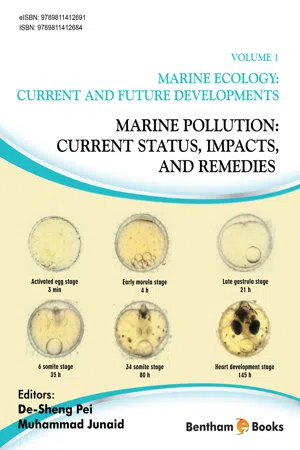
- English
- ePUB (mobile friendly)
- Available on iOS & Android
Marine Pollution: Current Status, Impacts, and Remedies
About This Book
While oceans are vast, they represent a fragile resource that must be protected if we want to protect our livelihoods and our planet. Marine pollution has been a topic of concern for a long time, and it has recently attracted the attention of scientists, environmentalists, economists, politicians and journalists in mainstream media,. Besides providing food, transportation routes and other resources, the oceans serve as a heat absorbing sink which offsets the extreme heating effects of climate change, but only to a limited degree. Pollution in marine environments such as the oceans, poses a threat to coastal communities by affecting the fauna and flora in the environment and the health of the nearby population. This has a disruptive effect on the health and economy of these communities. Marine Pollution: Current Status, Impacts and Remedies emphasizes the limitations of marine resources that relevant environments provide. Readers will find chapters on methods to assess pollution as well as important information for identifying, measuring, and remediating various pollutants. The book also covers some known pollutants (heavy metals, organic pollutants, microplastics) and ways to manage these substances. Other issues covered in the book include problems caused by invasive species, and the ecological problems caused by pollutants which affect local fauna and flora. This book will prove to be a useful resource for students, researchers, and policymakers, who are working in environmental science, marine conservation and allied fields.
Frequently asked questions
Information
Ecotoxicology of Heavy Metals in Marine Fish
Lizhao Chen, Sen Du, Dongdong Song, Peng Zhang, Li Zhang*
Abstract
* Corresponding author Li Zhang: Guandong Provincial Key Laboratory of Applied Marine Biology, South China Sea Institute of Oceanology, Chinese Academy of Sciences, Guangzhou, China; Tel/Fax: +86-20-89221322; E-mail: [email protected]
OCCURRENCE AND CHEMISTRY OF HEAVY METALS
Table of contents
- Welcome
- Table of Content
- Title
- BENTHAM SCIENCE PUBLISHERS LTD.
- FOREWORD
- PREFACE
- DEDICATION
- ACKNOWLEDGEMENTS
- List of Contributors
- An Introduction to the Recent Perspectives of Marine Pollution
- Sampling Pelagic Marine Organisms
- Macroelements and Microelements in Marine Ecosystems: An Overview
- Sulfur, Aluminum, Arsenic, Cadmium, Lead, Mercury, and Nickel in Marine Ecosystems: Accumulation, Distribution, and Environmental Effects
- Pollution Dynamics of Organic Contaminants in Marine Ecosystems
- Monitoring of Organic Pollutants: PCBs in Marine Ecosystem
- An Overview of Pollution Dynamics along the Pakistan Coast with Special Reference of Nutrient Pollution
- Ecotoxicology of Heavy Metals in Marine Fish
- Effects of Microplastics in Marine Ecosystem
- Toxicity Evaluation in Flora and Fauna Exposed to Marine Pollution
- Marine Medaka (Oryzias melastigma) as a Model System to Study Marine Toxicology
- Problems of Invasive Species: A Case Study from Andaman and Nicobar Islands, Andaman Sea, India
- Problems of Invasive Species
- Disturbance and Biodiversity of Marine Protected Areas
- Monitoring of Environmental Indicators and Bacterial Pathogens in the Muthupettai Mangrove Ecosystem, Tamil Nadu, India
- Marine Microbial Mettle for Heavy Metal Bioremediation: A Perception
- Polycyclic Aromatic Hydrocarbons (PAHs): Occurrence and Bioremediation in the Marine Environment
- Tackling Marin Pollution: Final Thoughts and Concluding Remarks